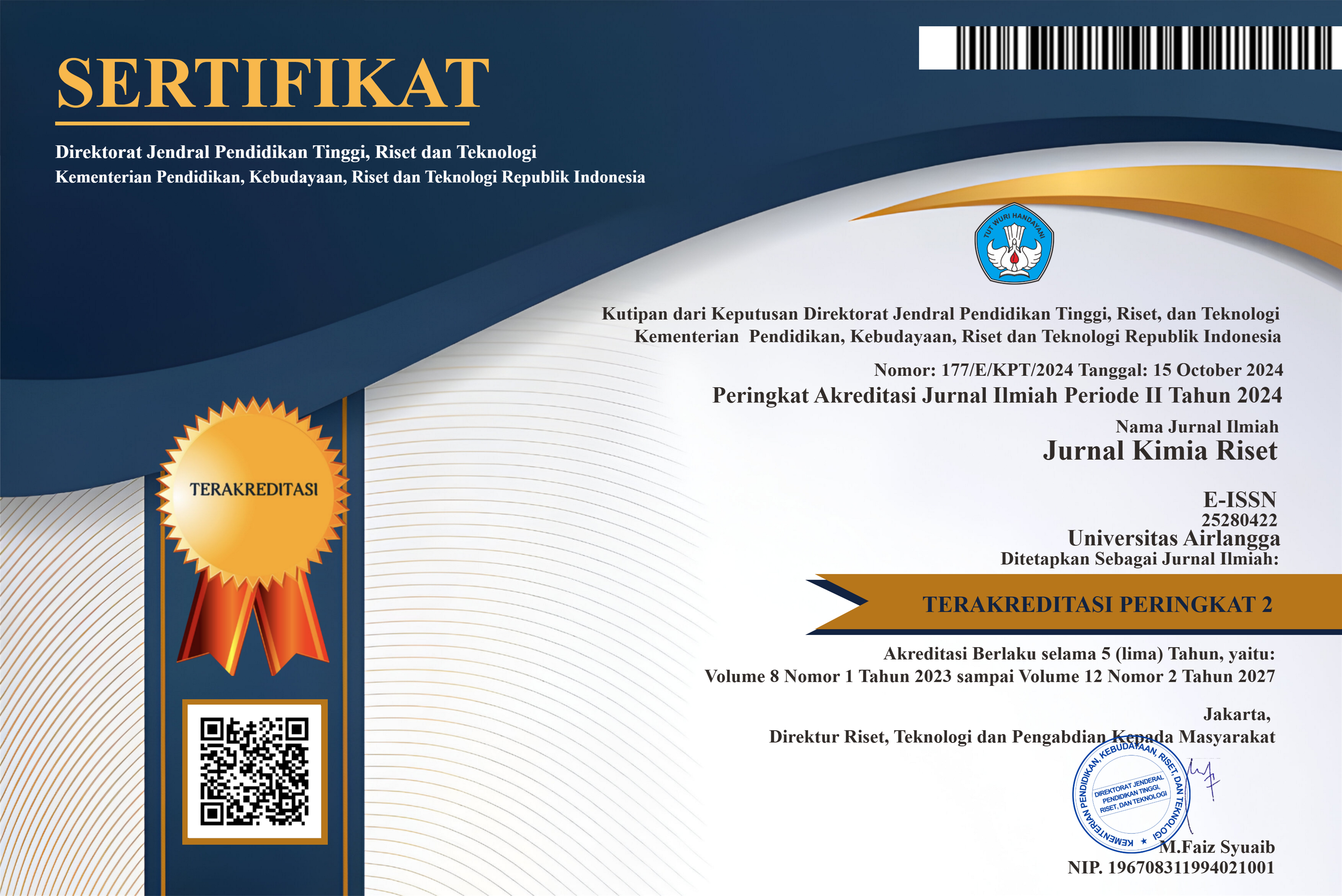SYNTHESIS AND CHARACTERIZATION OF NANO CHITOSAN-AVOCADO SEED STARCH AS EDIBLE FILMS
Downloads
The use of plastic as food packaging tends to cause problems because it is difficult to decompose; therefore, it can pollute the environment. The development of biodegradable plastics is an alternative to this problem. Chitosan, a bioplastic, can be used as a packaging material but has poor barrier properties. A biodegradable film was made from a mixture of plasticizer, nano chitosan, and avocado seed starch. Nanochitosan synthesis was carried out using the UAE method for 2 h at an amplitude of 50% to produce 0.7 µm sized particles. Films were formed using the casting method, and characterization was performed, which included functional group, thickness, color, and antioxidant tests. The FTIR spectrum showed that the interaction between nanochitosan and avocado seed starch occurred physically, marked by a shift in the wavenumber of the amide carbonyl group from 1646.60 cm-1 1549.99 cm-1. The film thickness was 0.10–0.15 cm with a darker color as the volume of nanochitosan used increased. Antioxidant analysis revealed that the LC50 value was between 150-250 ppm. The barrier properties of the resulting film against water vapor can inhibit strawberry fruit decay for 3–4 days at room temperature.
Azmin, S.N.H.M., Manan, Z.A., Alwi, S.R.W., Chua, L.S., Mustaffa, A.A. and Yunus, N.A., 2016. Herbal processing and extraction technologies. Separation and Purification Reviews, 45(4), pp.305–320.
Bai, Y., Liu, H., Lyu, H., Su, L., Xiong, J. and Cheng, Z.M.M., 2022. Development of a single-cell atlas for woodland strawberry (Fragaria vesca) leaves during early Botrytis cinerea infection using single-cell RNA-seq. Horticulture Research, 9(August 2021).
Bharathi, S., Ramesh, B., Kumaran, S., Radhakrishnan, M., Saravanan, D., Saravanan, P., Pugazhvendan, S.R. and Nalinasundari, M.S., 2021. No TitDevelopment of nanobiomaterial for wound healing based on silver nanoparticles loaded on chitosan hydrogelle. 3 Biotech, 11(12), pp.1–14.
Chen, X., Cui, F., Zi, H., Zhou, Y., Liu, H. and Xiao, J., 2019. Development and characterization of a hydroxypropyl starch/zein bilayer edible film. International Journal of Biological Macromolecules, 141, pp.1175–1182.
Coniwanti, P., Sari, D.M. and Febriana, R., 2016. Pengaruh Rasio Massa Pati Biji Alpukat dan Agar-Agar terhadap Pembuatan Edible Film. Jurnal Teknik Kimia, 22(2), pp.52–59.
Farhan, A. and Hani, N.M., 2017. Characterization of edible packaging films based on semi-refined kappa-carrageenan plasticized with glycerol and sorbitol. Food Hydrocolloids, 64, pp.48–58.
Fundo, J.F., Galvis-Sanchez, A.C., Delgadillo, I., Silva, C.L.M. and Quintas, M.A.C., 2015. The effect of polymer/plasticiser ratio in film forming solutions on the properties of chitosan films. Food Biophysics, 10, pp.324–333.
García, N.L., Ribba, L., Dufresne, A., Aranguren, M. and Goyanes, S., 2011. Effect of glycerol on the morphology of nanocomposites made from thermoplastic starch and starch nanocrystals. Carbohydrate Polymers, 84(1), pp.203–210.
Ismaya, F.C., Fithriyah, N.H. and Hendrawati, T.Y., 2021. Pembuatan Dan Karakterisasi Edible Film Dari Nata De Coco Dan Gliserol. Jurnal Teknologi, 13(1), pp.81–88.
Jongjareonrak, A., Benjakul, S., Visessanguan, W. and Tanaka, M., 2006. Effects of plasticizers on the properties of edible films from skin gelatin of bigeye snapper and brownstripe red snapper. Eur. Food Res. Technol., 222, pp.229–235.
Kamsiati, E., Herawati, H. and Purwani, E.Y., 2017. Potensi Pengembangan Plastik Biodegradable Berbasis Pati Sagu Dan Ubikayu Di Indonesia / The Development Potential of Sago and Cassava Starch-Based Biodegradable Plastic in Indonesia. Jurnal Penelitian dan Pengembangan Pertanian, 36(2), p.67.
Lubis, L.M., 2008. Ekstraksi Pati dari Biji Alpukat. Karya Ilmiah, pp.1–20.
Marsh, K. and Bugusu, B., 2007. Food packaging - Roles, materials, and environmental issues: Scientific status summary. Journal of Food Science, 72(3).
Otles, S., 2009. Handbook of Food Analysis Instruments, CRC Press, New York.
Romainor, A.N.B., Chin, S.F., Pang, S.C. and Bilung, L.M., 2014. Preparation and characterization of chitosan nanoparticles-doped cellulose films with antimicrobial property. Journal of Nanomaterials, 2014.
Shahbazi, Y. and Shavisi, N., 2018. Characterization of active nanochitosan film containing natural preservative agents. Nanomedicine Research Journal, 3(2), pp.109–116.
Shaikh, S., Yaqoob, M. and Aggarwal, P., 2021. An overview of biodegradable packaging in food industry. Current Research in Food Science, 4(February), pp.503–520.
Slavutsky, A.M. and Bertuzzi, M.A., 2014. Water barrier properties of starch films reinforced with cellulose nanocrystals obtained from sugarcane bagasse. Carbohydrate Polymers, 110, pp.53–61.
Susilowati, E. and Lestari, A.E., 2019. Preparation and Characterization of Chitosan-Avocado Seed Starch (KIT-PBA) Edible Film. JKPK (Jurnal Kimia dan Pendidikan Kimia), 4(3), p.197.
Suyatma, N.E., Tighzert, L., Copinet, A. and Coma, V., 2005. Effects of hydrophilic plasticizers on mechanical, thermal, and surface properties of chitosan films. Journal of Agricultural and Food Chemistry, 53(10), pp.3950–3957.
Yoksan, R. and Chirachanchai, S., 2010. Silver nanoparticle-loaded chitosan-starch based films: Fabrication and evaluation of tensile, barrier and antimicrobial properties. Materials Science and Engineering C, 30(6), pp.891–897.
Zareie, Z., Yazdi, F.T. and Mortazavi, S.A., 2020. Development and characterization of antioxidant and antimicrobial edible films based on chitosan and gamma-aminobutyric acid-rich fermented soy protein. Carbohydrate Polymers, p.116491.
Zhao, R., Guan, W., Zheng, P., Tian, F., Zhang, Z., Sun, Z. and Cai, L., 2022. Development of edible composite film based on chitosan nanoparticles and their application in packaging of fresh red sea bream fillets. Food Control, 132, p.N.PAG.
Zheng, K., Xiao, S., Li, W., Wang, W., Chen, H., Yang, F. and Qin, C., 2019. Chitosan-acorn starch-eugenol edible film: Physico-chemical, barrier, antimicrobial, antioxidant and structural properties. International Journal of Biological Macromolecules, 135, pp.344–352.
Copyright (c) 2023 Jurnal Kimia Riset

This work is licensed under a Creative Commons Attribution-NonCommercial-ShareAlike 4.0 International License.
COPYRIGHT NOTICE
1. By submitting the article to Jurnal Kimia Riset (JKR), the author has agreed to transfer some of the copyrights to the publisher of the research chemistry journal, Universitas Airlangga, indicated in the Copyright Transfer Agreement.
2. Authors still retain significant rights to use and share their own published articles for non-commercial purposes subject to Creative Commons Attribution-NonComercial 4.0 International License
3. All publications (printed/electronic) are open access for educational purposes, research, library, and other non-commercial purposes. Besides the purposes mentioned above, the editorial board is not responsible for copyright violations.















